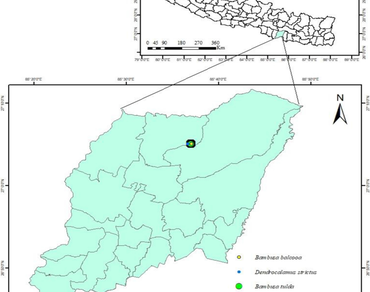Phytochemical screening, antioxidant and antibacterial activity of bamboo leaf collected from agroecosystem of the Central Siwalik region, Nepal
KC Bishnu Maya, Gauchan Dhurva Prasad, Khanal Sanjay Nath, Lamichhane Janardan
Research Articles | Published: 28 November, 2023
First Page: 2600
Last Page: 2606
Views: 3103
Keywords: Antioxidant, Bamboo, Fodder, Food, Siwalik
Abstract
Bamboo are the fastest growing, versatile, perennial woody grasses. Naturally provided with the essential phytochemicals, various species of bamboo have even been used as medicine by the tribal people since ancient times. To elucidate the medicinal value of bamboo (Bambusa tulda and Dendrocalamus strictus), the total phenolic and flavonoid contents of their leaves were quantified by spectrophotometer, and an in-vitro 2,2-diphenyl-1-picrylhydrazyl (DPPH) free radical scavenging assay was measured. The antibacterial activity was analyzed by the agar well diffusion method. The phytochemical screening in the methanol solvent extracts of D. strictus and B. tulda showed the presence of alkaloids, glycosides, saponins, phenols, terpenoids, flavonoids, and steroids, while D. strictus exhibited steroids in the hexane extract. Both the flavonoids and phenolic content of D. strictus (65.11 ± 1.33 μg QE/ml and 16.05 µg GAE/ml) were found to be higher than that of B. tulda (57.97 ± 0.22 μg QE/ml and 11.53 µg GAE/ml). The highest DPPH radical scavenging activity was exhibited by D. strictus (IC50 = 26.05 ± 0.09), and remarkable antibacterial activity was shown against four pathogenic bacteria (Bacillus subtilis, Enterococcus faecalis, Pseudomonas aeruginosa and Staphylococcus aureus) with a zone of inhibition ranging from 10.66 ± 0.57 to 9.0 ± 0.18 mm at a maximum concentration of 200 mg/ml. This study concludes that D. strictus and B. tulda have a wide spectrum of phytochemicals and could serve as complementary medicines along with mainstream drugs.

References
Abd EIslam NM, Ullah R, Waseem M (2013) Phytochemical analysis of medicinal plants Ranunculus arvensis. Life Sci J 10(7s):963–965
Bhardwaj DR, Sharma P, Bishist R, Navale MR, Kaushal R (2019) Nutritive value of introduced bambo species in the northwestern Himalayas, India. J for Res 30:2051–2060
KC BM, Gauchan DP, Khanal SN, Lamichhane J (2020a) Quantification of indole-3-acetic acid from Bambusa tulda Roxb seedlings using high performance liquid chromatography. Afr J Biotechnol 19(10):781–788
KC BM, Gauchan DP, Khanal SN, Chimouriya S, Lamichhane J (2020b) Extraction of indole-3-acetic acid from plant growth promoting rhizobacteria of bamboo rhizosphere and its effect on biosynthesis of chlorophyll in bamboo seedlings. Indian J Agric Res 54(6):781–786
KC BM, Gauchan DP, Khanal SN, Chimouriya S, Lamichhane J (2021) Amelioration of growth attributes of Bambusa nutans subsp. cupulata Stapleton by indole-3-acetic acid extracted from newly isolated Bacillus mesonae MN511751 from rhizosphere of Bambusa tulda Roxburgh. Biocatal Agric Biotechnol 31:101920
KC BM, Lamichhane J, Gauchan DP, Khanal SN (2022) Isolation and characterization of plant growth promoting rhizobacteria from bamboo rhizosphere and their role in plant growth promotion. Nepal J Sci Technol 21(1):1–12
Cheng Y, Wan S, Yao L, Lin D, Wu T, Chen Y, Zhang A, Lu C (2023) Bamboo leaf: a review of traditional medicinal property, phytochemistry, pharmacology, and purification technology. J Ethnopharmacol 306:116166
Clarke G, Ting KN, Wiart C, Fry J (2013) High correlation of 2, 2-diphenyl-1-picrylhydrazyl (DPPH) radical scavenging, ferric reducing activity potential and total phenolics content indicates redundancy in use of all three assays to screen for antioxidant activity of extracts of plants from the Malaysian rainforest. Antioxidants 2(1):1–10
Goyal AK, Brahma BK (2014) Antioxidant and nutraceutical potential of bamboo: an overview. Int J Fundam Appl Sci (IJFAS) 3(1):2–10
Hu J, Wang J, Li S, Yang B, Gong M, Li X, Zhang L, Tian J (2016) Phytochemical compositions, antioxidant and antimicrobial activities analysis of extracts from Vaccinium bracteatum Thunb. Leaves. J Appl Bot Food Qual 89:150–155
Jain SK, Rao RR (1977) A handbook of field and herbarium methods. Today and Tomorrows’ Printers and Publishers, New Delhi
Kimura I, Kagawa S, Tsuneki H, Tanaka K, Nagashima F (2022) Multitasking bamboo leaf-derived compounds in prevention of infectious, inflammatory, atherosclerotic, metabolic, and neuropsychiatric diseases. Pharmacol Ther 235:108159
Laleye FOA, Mensah S, Assogbadjo AE, Ahissou H (2015) Diversity, knowledge, and use of plants in traditional treatment of diabetes in the Republic of Benin. Ethnobot Res Appl 14:231–257
Ma Y, Yang Y, Gao J, Feng J, Shang Y, Wei Z (2020) Phenolics and antioxidant activity of bamboo leaves soup as affected by in vitro digestion. Food Chem Toxicol 135:110941
Neupane P, Lamichhane J (2020) Phytochemical profiling using HRLCMS and evaluation of antioxidant and antibacterial activities of Nepalese medicinal plants. Vegetos 33(4):628–640
Park EJ, Jhon DY (2010) The antioxidant, angiotensin converting enzyme inhibition activity, and phenolic compounds of bamboo shoot extracts. LWT-Food Sci Technol 43(4):655–659
Poudyal PP (2006) Bamboo of India (Sikkim), Bhutan and Nepal. New Hira Books Enterprises, GPO Box 2680, Kathmandu, Nepal, pp 1–74
Rai J, Sharma KR, Pokharel YR (2020) Antioxidant and alpha amylase inhibitory activity of Nepalese medicinal plants from Gorkha district. J Pharmacogn Phytother 12(2):28–35
Sadananda C, Singha LB, Tripathi OP (2021) Proximate analyses for dietary minerals in tender bamboo shoots of seven selected species and their processed products available in Arunachal Pradesh, India. Vegetos 34:738–744
Singh SA, Bora TC, Singh NR (2012) Preliminary phytochemical analysis and antimicrobial potential of fermented Bambusa balcooa shoots. Bioscan 7:391–394
Stapleton C (1994) Bamboos of Nepal: an illustrated guide. Royal Botanic Gardens Kew
Tao C, Wu J, Liu Y, Liu M, Yang R, Lv Z (2018) Antimicrobial activities of bamboo (Phyllostachys heterocycla cv. Pubescens) leaf essential oil and its major components. Eur Food Res Technol 244:881–891
Tewari DN (1994) A Monograph on Bamboo. International Book Distributors, Rajpur Road, Dehradun248001, Uttaranchal, India
Zhishen JM, Jianming W (1999) La determinación del contenido de flavonoides en la morera y sus efectos depuradores sobre los radicales superóxidos. Food Chem 64:555–559
Author Information
Department of Biotechnology, School of Science, Kathmandu University, Dhulikhel, Nepal